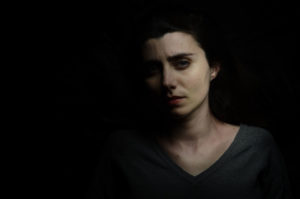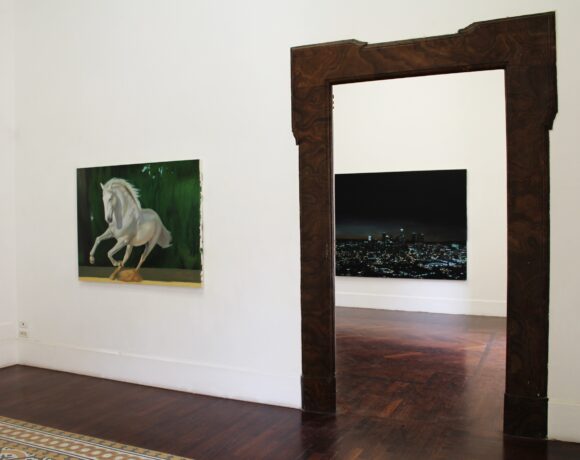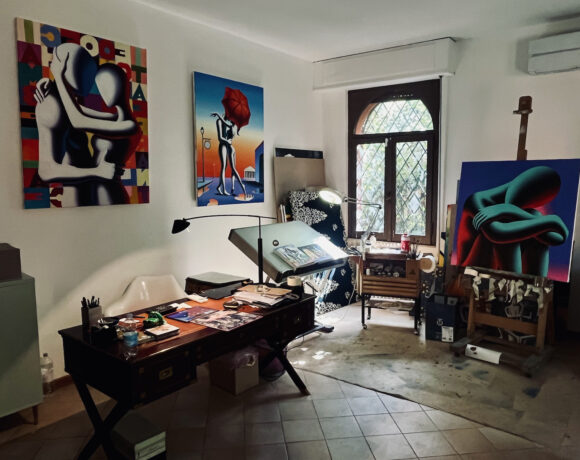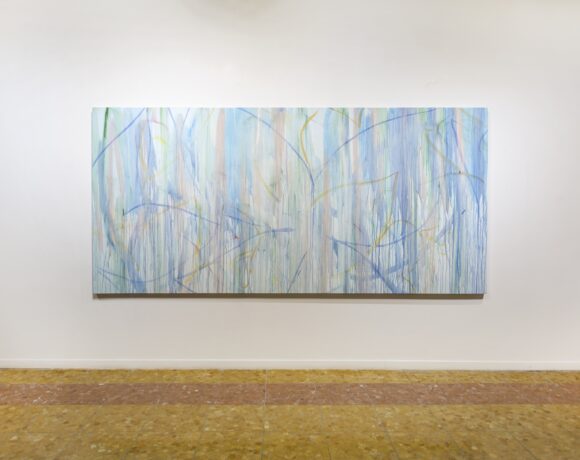Art messes up life and expecially today it seems to have taken the character of a grotesque, futile, cruel but also passionate drama, where things are not as they appear and beauty is difficult, as Ezra Pound said. In the case of Greta Bisandola, an artist who lives and works in Padua, beauty consists not only in the “hand”, in the ability to make works of figurative art, in making a work complete a character. Greta Bisandola’s research in fact revolves around faces and bodies, where the image is the undisputed protagonist, a guardian of mystery, meanings and truths, truths that the artist tries to grasp through the stratification of memory and the motions of the a soul of the human being, without following, as she herself states, a precise project, taking off from a terrain of uncertainty to offer a shared experience, intensifying and distancing things. Bisandola therefore realizes the ancient task of art, which “makes space and time”, giving great importance to chance, often a harbinger of truth.
By investigating human being, portraying figures, the painter from Monselice investigates painting as a material, and the void that has left the emptying of meaning of the image, abandoning itself to the visions of the unconscious, to randomness, to the “monsters” represented on the canvas : exhausted souls without status, nor history, imprisoned in unpleasant, distorted, disturbing aspects, among which stand out also the self-portraits of herself.
Approached to painters such as Schiele, Turner, Freud, Bisandola feels closer to the nephew of the famous psychoanalyst, as regards the practice of time, representing what is beyond the visible and the perceptible, beyond the deformity of faces and bodies , beyond the apparent irony that hides the fear of the not beautiful as harmonious, healthy, always trying to preserve its identity.
Greta Bisandola debuted in 2010 with a solo show at Palazzo Durini, Milan. Other solo shows have been dedicated to her in Bassano del Grappa, Turin, Berlin, and at the same time she has participated in various group exhibitions in Italy and in Germany. In her future plans there is a collective exhibition at the Diocesan Museum of Padua and a solo show at The Bank of Bassano collection.
The deformity that often inflicts on the faces and bodies of the subjects of your works seems to want to do emerge the cerebral and emotional suffering and complexity of the human being, is this a correct
interpretation?
Unfortunately, I do not have the key of my work and there is no intention but to find correspondences that during the execution translate only into a pleasure for the eyes. So I don’t know the secret of my characters. But I can say that through the human I try to investigate painting. The complexity of the human combines the complexity of painting, but they are two separate entities in a certain sense. Painting for me means first of all having a physical experience with the subject. The face and the body are great containers in this sense.
In this sense, what does identity mean for you?
I am very attached to the figure, therefore to figurative painting, even if for me today the image has been emptied of everything, it is no longer the bearer of a meaning. And it is precisely this emptiness that interests me. There is a surplus in the work of the faces that I have realized up to now that tries to create fractures inside the shape to be able to talk about something else. The identity of my subjects is in excess and over the top, in an attempt to shatter itself. It wants to shatter because in reality it does not accept a measure, it does not want “an identity”, it wants everything, it aspires to infinity and therefore it cannot contain itself. The subject opens up and pursues the matter because it is alive and moves, it represents the identity of the real, because the world never adheres to our scheme. Painting, on the other hand, is matter and the world.
When did you start painting and why?
I was a child, first I started drawing, then painting. The beginning of everything is a very distant memory, a long road full of experiences and continuous changes. How to explain why something turns on so much passion and constantly calls you to yourself, like a voice in your head? I paint because this is my singular desire, it is my countermelody, perhaps it is a prevaricating act in the attempt to assert myself. In desire there is something that has not yet been written, something that has not yet happened but hopes to do so, which will come. So I paint to throw myself forward with the fear that characterizes me because, inspired by an interview with Giacometti, I like adventure.
Yours is a turbulent painting, however after finishing a work, do you feel satisfied by your
work, in harmony with yourself?
Of course, this is the ultimate goal, to feel absolutely satisfied. When a work ends I feel fulfilled and in the right place.
In “Luce propria”, you also highlighted your face, is it a sort of act of pacification, a wish to unravel?
When I paint there is always in my research a desire to reveal, above all to myself. The most successful work is the one that separates me from myself, the one that provokes my amazement, showing me something I didn’t know and I didn’t know I could do. I often use my face in paintings, it is the face with which I have the most confidence, the one at hand. It will seem incredible, but often a painter’s problems involve technical issues.
You were associated with painters such as Lucien Freud, Turner, Bacon … Who do you feel closest to?
Among these Lucian Freud, for the practice of time, and because he seems to me a “builder” of bodies. It tears a face to pieces and at the same time keeps it united and solid. I love that special technique that becomes a character.
The humanity without filters that you represents, disfigured and devastated, springs from the historical contingency, contemporary or by the very essence of the human being that is immutable?
Everything that concerns us and that surrounds us as human beings, the social structure, our experiences, what we are without knowing, manifests and is part of what we create, which remains, after all, always within a limit tangible. The contemporary historical contingency creates dichotomies for me, so humanity in my work does not want to talk about humanity. It is true that there are no filters, because in fact, as I have already mentioned, my humanity wants to become a container of all the containable. Contemplate a void as a gateway. It comes from the possibility of no longer having to tell a story.
Nature and history, how do these two aspects relate to your works?
History is all that we know, it characterizes us in spite of ourselves and it is material from which, inevitably, I feel I must draw in some way to be able to go on. In my work, on the other hand, nature is perceived as a process, a metamorphosis, a space of rest but in movement, where gestures are perhaps more authentic, easier. It seems to me that it manifests itself in my works in an isolated manner, cut out, it never creates an environment.
In your opinion, in the wake of the thought of Benjamin, is it true that the work of art today more than ever states how ruin dropping any beauty residue? Does beauty looks like a fossil from an era far?
The word “beauty” has an objective character, it seems to speak of a harmony shared by all in the same way. It always seems to refer to a consolidated model. In addition it is forced to tell a story inextricably linked to its appearance, to its shape as a perfect coincidence of itself, a narrow paralyzing envelope. Today the ugly becomes beautiful because the distortion is a living tension towards the real, the image does not want to tell itself as it is, but seeks elsewhere. Because the task of art is to make the invisible visible, it is transcendence. Even figurative painting feels this necessity which is why it is deformed in some way. Art is life, and life has to do with the event, takes us by surprise, overpowers us and drags, is not acceptable, it is unique.
Your works “make time”, bring the perceptible to maturity, fulfilling the ancient task of art, do you feel part of this mission?
In making contemporary art there is an individuality that places the artist only at the center of himself, of his own need, of his own incomprehensible need in some way. This perhaps especially in painting. The hope is however to leave something that lasts over time, an object endowed with a certain degree of autonomy, at least for me, which can at some point be validated. But the object succeeded even if only for those who built it, enough and progresses, in this sense, artistic creation is a damned private affair.
Any projects for the future and wishes to be implemented?
Soon I will have some shows, a collective exhibition at the Diocesan Museum of Padua and a solo showat The Bank in Bassano. The desire is to continue to paint.
Info:
 Greta Bisandola. Ph. credit Andrea Rosset
Greta Bisandola. Ph. credit Andrea Rosset
 Greta Bisandola, Il Bambino, 90 x 90 cm, 2019, olio su tela
Greta Bisandola, Il Bambino, 90 x 90 cm, 2019, olio su tela
 Greta Bisandola, Madre, 80 x 80 cm, 2014, olio su tela
Greta Bisandola, Madre, 80 x 80 cm, 2014, olio su tela
 Greta Bisandola, Pauline, 50 x 50 cm, 2011, olio su tela
Greta Bisandola, Pauline, 50 x 50 cm, 2011, olio su tela
 Greta Bisandola, Sottogiardino, 40 x 70 cm, 2014 olio su tela
Greta Bisandola, Sottogiardino, 40 x 70 cm, 2014 olio su tela
 Greta Bisandola, Esercizio, 50 x 50 cm, 2013 olio su tela
Greta Bisandola, Esercizio, 50 x 50 cm, 2013 olio su tela
Journalist, blogger and social media editor from Campania. i graduated in literature and philology and I gained a master in art and organization of cultural events. I love cinema, art, music, literature, especially Russian, French and Italian. I read a lot, both narrative and non-fiction. I share Picasso’s thoughts on art: “Art helps us to recognize the truth”.






NO COMMENT